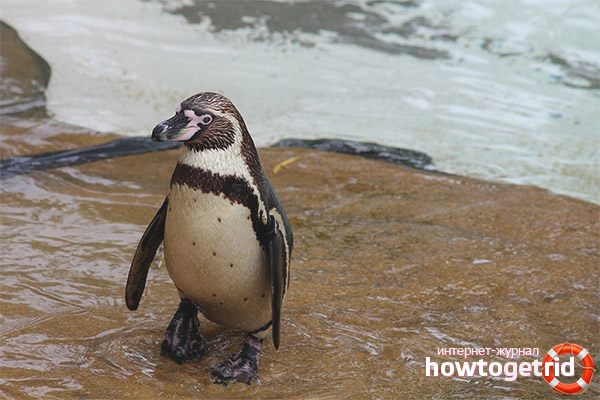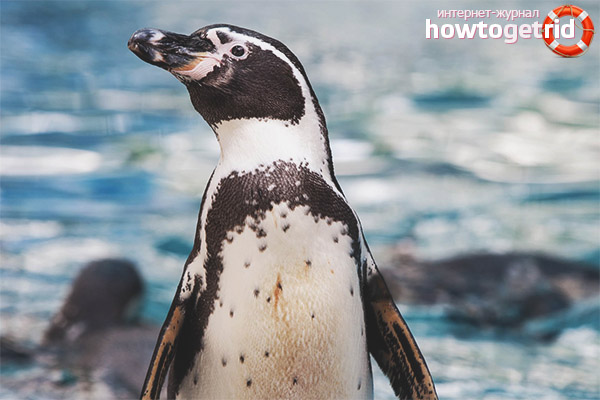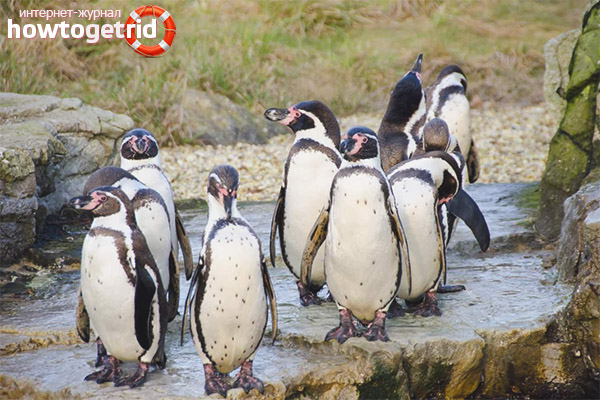The content of the article
Humboldt Penguin is a bird of the penguin family, with a fairly wide range of distribution in the subtropical region of the Pacific coast.
Habitat
The vast majority of their lives, birds of this species spend hunting, and the time spent in water directly depends on when the breeding season begins. For example, those representatives of a species that have not yet created pairs for nesting have been in the water for at least 60 hours before going on land. The maximum duration of a penguin in the aquatic environment reaches 164 hours (long trips and exploring a new area).
During nesting in water, these waterfowl spend much less time (no more than a day, maximum values - about 36 hours). Like most of its relatives, such waterfowls as penguins on the rocky Pacific coast have a rest. Growing offspring is carried out in the built nests. Often, for their nesting birds use natural caves.
Appearance
The head of the penguin is black, with characteristic bright stripes located under the eyes and forming a kind of hoop that runs along the entire head and connects on the chin, forming a bend that resembles a horseshoe in shape.
One of the characteristic features of this species that distinguishes it from its relatives is the presence of a continuous dark strip on the chest. It helps to immediately distinguish the Humboldt penguin from the Magellanic.
Power Features
The basic diet of representatives of penguins of this species is pelagic fish (large anchovy, garfish, sardines, as well as squids). Features of penguin forage territories determine the predominance of certain types of marine inhabitants in the diet. Also, these birds often feast on herring and atherina.
Nesting and breeding
Such a species of birds as Humboldt penguins is distinguished by its monogamous nature. Male individuals jealously guard the nesting area from uninvited guests, and when danger arises, they immediately attack the enemy or competitor. At the same time, the result of such a rather serious skirmish is the death of an uninvited guest.
Penguins of this species can breed under favorable climatic conditions almost year-round. Directly, the breeding season begins with the beginning of spring and ends with the onset of winter. Peak breeding birds occur in mid-spring and high summer. It should also be noted that the breeding period coincides with the beginning of molting of birds. When the penguin molts, it remains on land for two weeks, while all this time it literally starves. After the end of the molt, the bird goes to sea and, finally, is fattened, making up for the strength and kilograms lost during the change of feather dress. After this, representatives of this species return to land to breed future offspring.
To equip their nests, penguins choose places that are well protected from direct sunlight, as well as predators that can come from both land and sea. The most common place for erecting nests is the guano deposits located along the coastline. The nest is located in a small hole in which the female produces eggs.
The number of eggs in one clutch is up to 2 pcs.The process of incubating eggs is carried out by both representatives of the couple, in turn. After hatching of the chicks, adults also share the duties of feeding their offspring, which implies short-term immersion of birds in water for food, which are carried out at certain time intervals. Young chicks become independent after the first molt. The life span of penguins in the natural habitat is about 20 years.
Behavior of species

Penguins are quite sensitive to representatives of the human race, the appearance of researchers or tourists in the nesting sites of this species of birds, as a rule, violates the natural breeding process. No matter how strange it may sound, even the presence of a person at a sufficiently large distance (at least 150 meters) causes the penguin to increase the pulse rate. In order to calm down, the bird will need at least half an hour to restore the emotional background and calm the rapid heartbeat.
Non-breeding individuals of penguins for feeding swim quite far, exploring the area and not returning to the place of settlement for quite a long time. Penguins involved in feeding and raising offspring, as a rule, rarely go out for night walks and spend less time in the water, giving all their energy and attention to the chicks.
Recent studies show that Humboldt penguins have a rather acute sense of smell, which helps to quickly find both their hole and offspring.
I would like to draw attention to the fact that representatives of this type of penguin are very dependent on the level of illumination. For example, in twilight and darkness, they cannot find the prey necessary for food. However, these waterfowl are well seen both in water and on land.
Video: Humboldt Penguin (Spheniscus humboldti)











Submit